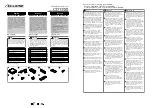
Glossary
Page A-2
Instruction Manual: TT1260 Standard Definition Professional Receiver/Decoder
ST.TM.E10100.1
B3ZS
Bipolar with Three Zero Substitution:
A method of eliminating long zero strings in a transmission. It is used to
ensure a sufficient number of transitions to maintain system synchronisation when the user data stream contains
an insufficient number of 1s to do so. B3ZS is the North American equivalent of the European HDB3.
Backward Compatibility
Refers to hardware or software that is compatible with earlier versions.
BAT
Bouquet Association Table:
Part of the service information data. The BAT provides information about bouquets.
It gives the name of the bouquet and a list of associated services.
baud rate
The rate of transfer of digital data when the data comprises information symbols that may consist of a number of
possible states. Equivalent to bit-rate when the symbols only have two states (1 and 0). Measured in Baud.
BER
Bit Error Rate:
A measure of transmission quality. The rate at which errors occur in the transmission of data bits
over a link. It is generally shown as a negative exponent, (e.g. 10
-7
means that 1 in 10,000,000 bits are in error).
BISS
Basic Interoperable Scrambling System:
Non-proprietary encryption from EBU (Tech3290).
BISS-E
Basic Interoperable Scrambling System:
with Encrypted keys.
Bit-rate
The rate of transfer of digital data when the data comprises two logic states, 1 and 0. Measured in bit/s.
Block; Pixel Block
An 8-row by 8-column matrix of luminance sample values, or 64 DCT coefficients (source, quantised, or
dequantised).
Bouquet
A collection of services (TV, radio, and data, or any combination of the three) grouped and sold together, and
identified in the SI as a group. A single service may be in several bouquets.
B-Picture; B-Frame
Bi-directionally Predictive Coded Picture/Frame:
A picture that is coded using motion-compensated prediction
from previous I or P frames (forward prediction) and/or future I or P frames (backward prediction). B frames are not
used in any prediction.
BPSK
Binary Phase Shift Keying:
A data modulation technique.
Buffer
A memory store used to provide a consistent rate of data flow.
BW
Bandwidth:
The transmission capacity of an electronic line such as (among others) a communications network,
computer bus, or broadcast link. It is expressed in bits per second, bytes per second or in Hertz (cycles per
second). When expressed in Hertz, the frequency may be a greater number than the actual bits per second,
because the bandwidth is the difference between the lowest and highest frequencies transmitted. High bandwidth
allows fast transmission or high-volume transmission.
Byte-mode
Each byte is delivered separately in the ASI Transport Stream, with stuffing data added between the Bytes to
increase the data rate to 270 Mbit/s. See DVB Document A010 rev. 1, Section B3.3, (ASI) Layer-2 Transport
Protocol.
CA
Conditional Access:
The technology used to control the access to viewing services to authorised subscribers
through the transmission of encrypted signals and the programmable regulation of their decryption by a system
such as viewing cards.
CAT
Conditional Access Table:
Part of the MPEG-2 Program Specific Information (PSI) data. Mandatory for MPEG-2
compliance if CA is in use.
C-Band
The portion of the electromagnetic spectrum, which spans the frequency range of approximately 4 GHz to 6 GHz.
Used by communications satellites. Preferred in tropical climates because it is not susceptible to fading.
CCIR
See:
ITU-R.
CCITT
See:
ITU-T.
Channel
A narrow range of frequencies, part of a frequency band, for the transmission of radio and television signals
without interference from other channels.
In the case of OFDM, a large number of carriers spaced apart at precise frequencies are allocated to a channel.
Channel Coding
A way of encoding data in a communications channel that adds patterns of redundancy into the transmission path
in order to improve the error rate. Such methods are widely used in wireless communications.
Chrominance
The colour part of a TV picture signal, relating to the hue and saturation but not to the luminance (brightness) of
the signal. In a
composite-coded
colour system, the colour information (chrominance, often referred to as
chroma) is modulated onto a high frequency carrier and added to the monochrome-format video signal carrying
the luminance (Y). In a
component-coded
colour system, the two colour-difference signals (R-Y)(B-Y) usually
referred to as C
R
C
B
(digital) or P
R
P
B
(analogue), are used to convey colour information. When C
R
C
B
(P
R
P
B
)
is
added to the luminance
(Y), the complete picture information is conveyed as YC
R
C
B
(YP
R
P
B
).
Closed Captioning
A TV picture subtitling system used with 525-line analogue transmissions.
CODE
Create Once Distribute Everywhere.
Codec
The combination of an En
co
der and a complementary
Dec
oder located respectively at the input and output of a
transmission path.
















































